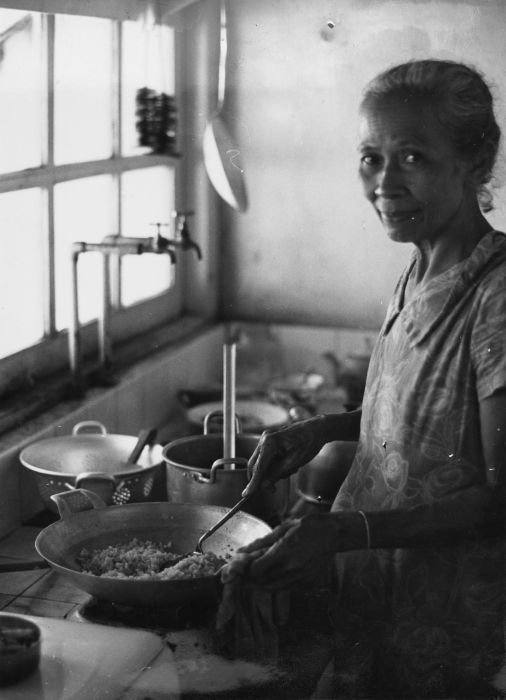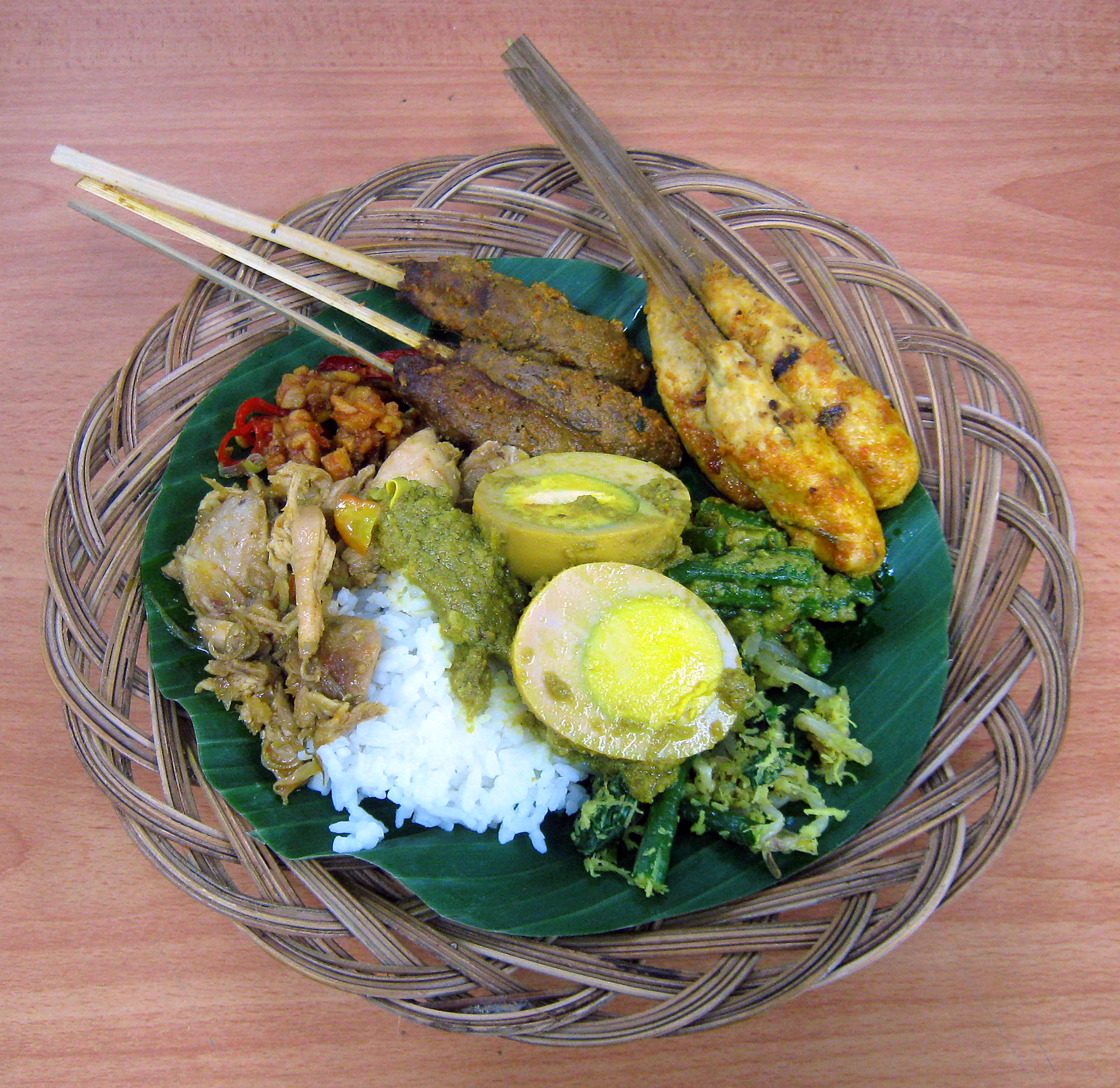|
Nasi Tempong
Nasi tempong ( jv, ꦱꦼꦒꦠꦺꦩ꧀ꦥꦺꦴꦁ, sega témpong; Pegon: ) is an Indonesian rice dish, typical food of Osing people in Banyuwangi, consists of steamed rice with boiled vegetables (includes boiled spinach, cosmos and basil leaves), tofu, tempeh, corn fritter and fried ariid catfish. This rice dish served with ''kencur'' sambal or ''terasi'' sambal. The "tempong" term is a word in Osing language which means "to be slapped" in English. Thus the nasi tempong named because the spicy taste of ''nasi tempong'' which giving a sensation like being slapped. See also *Cuisine of Indonesia *Javanese cuisine *Nasi ambeng *Nasi bakar *Nasi campur *Nasi gandul *Nasi goreng *Nasi pecel Nasi pecel is an Indonesian rice dish from Java served with pecel (cooked vegetables and peanut sauce). Referen ...
|
Osing Language
The Osing language (Osing: ''Basa Using''; id, Bahasa Osing), locally known as ''the language of Banyuwangi'', is the language of the Osing people of East Java, Indonesia. Some Osing words have the infix /-y-/ 'ngumbyah', 'kidyang', which are pronounced /ngumbah/ and /kidang/ in standard Javanese, respectively. Divergent Osing vocabulary includes: *''osing/sing'' 'not' (standard Javanese: ''ora'') *''paran'' 'what' (standard Javanese: ''åpå'') *''kadhung'' 'if" (standard Javanese:yèn,lèk,nèk) *''kelendhi'' 'how' (standard Javanese:kepiyè,piyè) *''maning'' 'again' (standard Javanese:manèh,the Banyumasan dialect of Javanese also uses 'maning') *''isun'' 'I/me' (standard Javanese:aku) *''rikå'' 'you' (standard Javanese:kowè,the Banyumasan dialect also uses "rikå") *''ring''/''nong'' 'in/at/on' (standard Javanese:ning,nang,the Balinese language and Old Javanese Old Javanese or Kawi is the oldest attested phase of the Javanese language. It was spoken in the eas ... [...More Info...] [...Related Items...] OR: [Wikipedia] [Google] [Baidu] |
Corn Fritter
Corn fritters are fried cakes of a dough or batter made of, or containing a featured quantity of maize ( corn). Originating in Native American cuisine, they are a traditional sweet and savory snack in the Southern United States, as well as Indonesia where they are known as '' perkedel jagung'' or '' bakwan jagung''. History Native Americans had been using ground corn (maize) as food for thousands of years before European explorers arrived in the New World. Corn-based products, such as corn flatbread, arepa and cornbread were staple foods in Pre-Columbian Americas. Native Americans did not use deep frying techniques, however, which require ample supplies of cooking oil as well as equipment in which the oil can be heated to high temperatures. European settlers learned recipes and processes for corn dishes from Native Americans, and soon devised their own cornmeal-based recipe variations of European breads made from grains available on that continent. The corn fritter probabl ... [...More Info...] [...Related Items...] OR: [Wikipedia] [Google] [Baidu] |
Nasi Goreng
''Nasi goreng'' (English pronunciation: ) is a Southeast Asian fried rice dish, usually cooked with pieces of meat and vegetables. One of Indonesia's national dishes, it is also eaten in Malay-speaking communities in countries such as Malaysia, Singapore and Brunei, and has gained popularity in Sri Lanka through migrations from the Malay Archipelago, in countries like Suriname via Indonesian immigrant communities, and in the Netherlands through its colonial ties with Indonesia. ''Nasi goreng'' is distinguished from other Asian fried rice preparations by its distinct smoky aroma, and caramelised yet savoury undertones of flavour. There is no single defined recipe for ''nasi goreng'', and its composition and preparation varies greatly from household to household. ''Nasi goreng'' has long been considered an important staple of Indonesian cuisine. In 2018, it is officially recognized by the Indonesian government as one of the country's five national dishes. A ubiquitous meal thr ... [...More Info...] [...Related Items...] OR: [Wikipedia] [Google] [Baidu] |
Nasi Gandul
Nasi gandul or in Javanese sega gandhul (Hanacaraka: ꦱꦼꦒꦒꦤ꧀ꦝꦸꦭ꧀) is a rice dish served in rich, sweet, savoury and spicy beef soup, specialty of Pati Regency, Central Java, Indonesia. Nasi gandul consists of steamed rice topped with slices of beef served in spicy soup with savoury flavour in golden-brownish colour. Nasi gandul is somewhat quite similar to other Indonesian dishes; beef semur, tongseng and Javanese gulai. Etymology The term ''gandul'' in Javanese language means "hanging". The name was derived from the way of travelling vendor selling this food in the past; i.e. by using ''pikulan'' or balancing rod; in which the rice and other ingredients are placed "hanging" on the rod. Today however, most of nasi gandul sellers are not mobile and not travelling anymore; most open modest ''warung'' eatery instead. Ingredients Nasi gandul uses slices of beef, sometimes offals are also included; cooked in spicy and savoury coconut milk-based soup. The sp ... [...More Info...] [...Related Items...] OR: [Wikipedia] [Google] [Baidu] |
Nasi Campur
Nasi campur (Indonesian for 'mixed rice'), also known as nasi rames or sega campur (; ) in Java, refers to an Indonesian dish of a scoop of ''nasi putih'' (white rice) accompanied by small portions of a number of other dishes, which includes meats, vegetables, peanuts, eggs, and fried-shrimp krupuk. Depending on origin, a nasi campur vendor might serve several side dishes, including vegetables, fish, and meats. It is a staple meal from Indonesia and popular in Malaysia, Singapore, Brunei, and southern Thailand, and also the Netherlands through its colonial ties with Indonesia. A similar form called ''chanpurū'' exists in Okinawa. Origin and variations Nasi campur is a ubiquitous dish around Indonesia and as diverse as the Indonesian archipelago itself, with regional variations. There is no exact rule, recipe, or definition of what makes a nasi campur, since Indonesians and by large Southeast Asians commonly consume steamed rice surrounded with side dishes consisting of vegetabl ... [...More Info...] [...Related Items...] OR: [Wikipedia] [Google] [Baidu] |
Nasi Bakar
Nasi may refer to: Food Dishes Nasi Goreng is an Indonesian and Malay word for ''cooked rice'', featured in many Southeast Asian dishes *Nasi goreng, a popular rice dish often simply called ''nasi'' *Other Southeast Asian ''nasi'' dishes: **Nasi ambeng **Nasi bakar ** Nasi bogana **Nasi campur **Nasi dagang ** Nasi goreng jawa **Nasi goreng pattaya ** Nasi gurih ** Nasi jamblang **Nasi kapau **Nasi kari **Nasi kebuli **Nasi kerabu **Nasi kucing **Nasi kuning **Nasi lemak **Nasi lengko **Nasi liwet ** Nasi mandi **Nasi minyak **Nasi padang **Nasi paprik **Nasi pecel **Nasi tempong **Nasi tim **Nasi timbel **Nasi tutug oncom **Nasi tumpang **Nasi tumpeng ** Nasi uduk **Nasi ulam Restaurant *Pelita Nasi Kandar, a Malaysian restaurant chain Religion *Nasi (Hebrew title), meaning ''prince'' in Biblical Hebrew and ''president'' in Modern Hebrew *Nasi', an Islamic concept mentioned in the Qur'an People *Nasi Manu, a New Zealand professional rugby player *Nasi (singer), a Brazilian singe ... [...More Info...] [...Related Items...] OR: [Wikipedia] [Google] [Baidu] |
Nasi Ambeng
Nasi ambeng or Nasi ambang is an Indonesian fragrant rice dish that consists of - but is not limited to - steamed white rice, chicken curry or chicken stewed in soy sauce, beef or chicken rendang, sambal goreng (lit. fried sambal; a mildly spicy stir-fried stew commonly made with firm tofu, tempeh, and long beans) urap, bergedel, and serunding. It is a popular Javanese cuisine, especially within the Javanese-Malay communities in Singapore and the Malaysian states of Johor and Selangor where they also added fried noodles as additional condiments. Nasi ambeng is often served communal dining-style on a platter to be shared among four to five people; especially during festive or special occasions such as a kenduri. See also *Nasi campur *Nasi bakar *Javanese cuisine *Tumpeng Tumpeng ( Javanese: ; Balinese: ) is an Indonesian cone-shaped rice dish with side dishes of vegetables and meat originating from Javanese cuisine of Indonesia. Traditionally featured in the '' slamatan ... [...More Info...] [...Related Items...] OR: [Wikipedia] [Google] [Baidu] |
Cuisine Of Indonesia
Indonesian cuisine is a collection of various regional culinary traditions that formed the archipelagic nation of Indonesia. There are a wide variety of recipes and cuisines in part because Indonesia is composed of approximately 6,000 populated islands of the total 17,508 in the world's largest archipelago,"Indonesian Cuisine." . Accessed July 2011. [...More Info...] [...Related Items...] OR: [Wikipedia] [Google] [Baidu] |
English Language
English is a West Germanic language of the Indo-European language family, with its earliest forms spoken by the inhabitants of early medieval England. It is named after the Angles, one of the ancient Germanic peoples that migrated to the island of Great Britain. Existing on a dialect continuum with Scots, and then closest related to the Low Saxon and Frisian languages, English is genealogically West Germanic. However, its vocabulary is also distinctively influenced by dialects of France (about 29% of Modern English words) and Latin (also about 29%), plus some grammar and a small amount of core vocabulary influenced by Old Norse (a North Germanic language). Speakers of English are called Anglophones. The earliest forms of English, collectively known as Old English, evolved from a group of West Germanic (Ingvaeonic) dialects brought to Great Britain by Anglo-Saxon settlers in the 5th century and further mutated by Norse-speaking Viking settlers starting in the 8th and 9th ... [...More Info...] [...Related Items...] OR: [Wikipedia] [Google] [Baidu] |
Sambal
Sambal is an Indonesian chilli sauce or paste, typically made from a mixture of a variety of chilli peppers with secondary ingredients, such as shrimp paste, garlic, ginger, shallot, scallion, palm sugar, and lime juice. ''Sambal'' is an Indonesian loan-word of Javanese origin (). It originated from the culinary traditions of Indonesia, and is also an integral part of the cuisines of Malaysia, Sri Lanka, Brunei and Singapore. It has also spread through overseas Indonesian populations to the Netherlands and Suriname. (Indonesian) Various recipes of ''sambals'' usually are served as hot and spicy condiments for dishes, such as ''lalab'' (raw vegetables), ''ikan bakar'' (grilled fish), ''ikan goreng'' (fried fish), '' ayam goreng'' (fried chicken), ''ayam penyet'' (smashed chicken), '' iga penyet'' (ribs) and various '' soto'' soup. There are 212 variants of sambal in Indonesia, with most of them originating from Java. History Sambal is often described as a hot and spicy In ... [...More Info...] [...Related Items...] OR: [Wikipedia] [Google] [Baidu] |
Terasi
Shrimp paste or prawn sauce is a Fermentation, fermented condiment commonly used in Southeast Asian cuisine, Southeast Asian and Southern Chinese cuisines. It is primarily made from finely crushed shrimp or krill mixed with salt, and then fermented for several weeks. They are either sold in their wet form or are sun-dried and either cut into rectangular blocks or sold in bulk. It is an essential ingredient in many curry, curries, sauces and sambal. Shrimp paste can be found in many meals in Cambodia, Indonesia, Laos, Malaysia, Myanmar, Philippines, the Philippines, Singapore, Thailand, and Vietnam. It is often an ingredient in Dip (food), dip for fish or vegetables. History ''Trasi'', (Indonesian cuisine, Indonesian-Javanese cuisine, Javanese fermented shrimp paste; alt. spelling: ''terasi''), as mentioned in two ancient Sundanese language, Sundanese scriptures, ''Carita Purwaka Caruban Nagari'' and ''Mertasinga'', had been around in Java before sixth century. According to ' ... [...More Info...] [...Related Items...] OR: [Wikipedia] [Google] [Baidu] |
Sambal
Sambal is an Indonesian chilli sauce or paste, typically made from a mixture of a variety of chilli peppers with secondary ingredients, such as shrimp paste, garlic, ginger, shallot, scallion, palm sugar, and lime juice. ''Sambal'' is an Indonesian loan-word of Javanese origin (). It originated from the culinary traditions of Indonesia, and is also an integral part of the cuisines of Malaysia, Sri Lanka, Brunei and Singapore. It has also spread through overseas Indonesian populations to the Netherlands and Suriname. (Indonesian) Various recipes of ''sambals'' usually are served as hot and spicy condiments for dishes, such as ''lalab'' (raw vegetables), ''ikan bakar'' (grilled fish), ''ikan goreng'' (fried fish), '' ayam goreng'' (fried chicken), ''ayam penyet'' (smashed chicken), '' iga penyet'' (ribs) and various '' soto'' soup. There are 212 variants of sambal in Indonesia, with most of them originating from Java. History Sambal is often described as a hot and spicy In ... [...More Info...] [...Related Items...] OR: [Wikipedia] [Google] [Baidu] |





